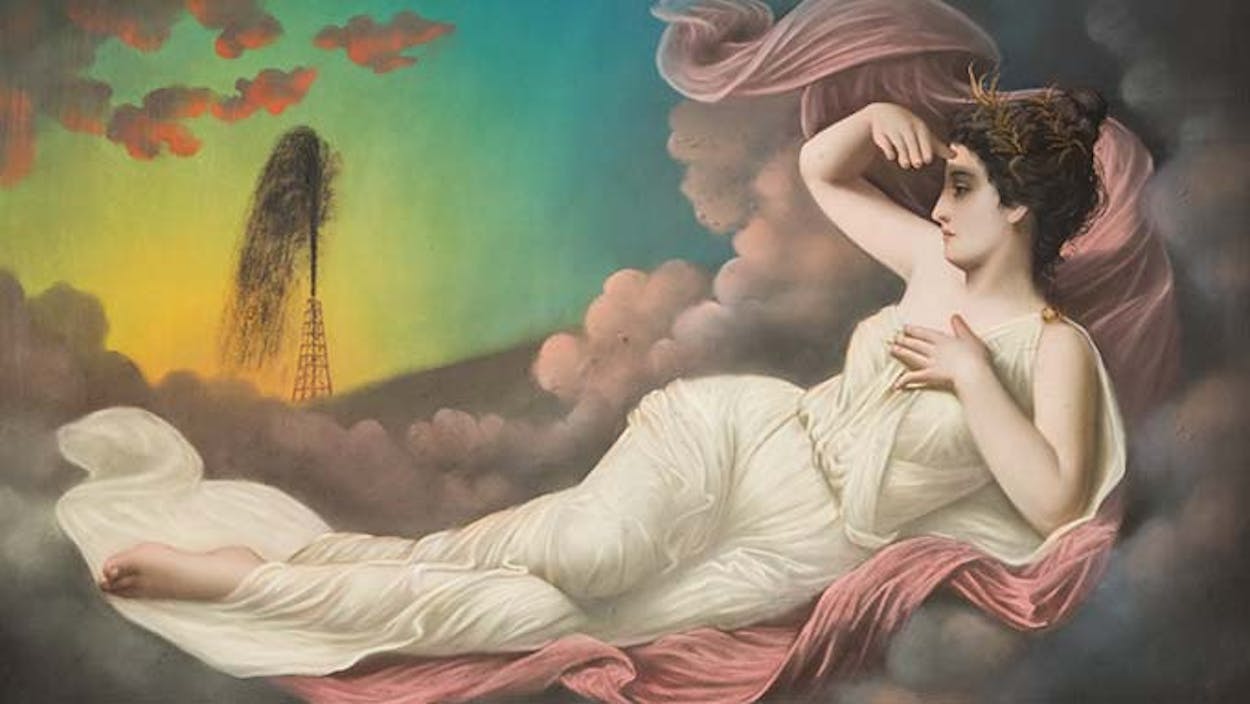January 10, 1901, could be the most important day in Texas history. At about ten-thirty that morning, on a low hill four miles south of Beaumont called Sour Springs Mound, the oil well known as Spindletop came in. The gusher began with a roar, shaking the ground under the derrick, spewing first mud, then rocks, then six tons of four-inch pipe out of the ground, hurling it into the air like soda straws. Then a 150-foot plume of oil erupted, and it spouted 100,000 barrels a day for nine days before drillers could cap it. Spindletop marked the beginning of the modern petroleum industry. Texas—and the world—would never be the same.
Spindletop will always be associated with Pattillo Higgins, the abrasive prophet who had insisted that there was oil under Sour Springs Mound for ten years before the well came in. Higgins was a most peculiar man. Born in 1863, he grew up to be a tough and a rowdy, the despair of his parents. He lost his left arm after a gunfight with a lawman when he was seventeen, but even then he was able to make a living as a logger. When he was in his early twenties, however, he experienced a religious conversion at a Baptist revival meeting. He settled down in Beaumont and became a respectable businessman, establishing a brick-making company and teaching Sunday school at the First Baptist Church.
Higgins was a visionary, and he developed a plan to build a brick-making plant on Sour Springs Mound, so named for the oil that seeped into the springs. The plant was to be part of a utopian industrial community called Gladys City. The furnaces would be powered by burning oil, workers would be housed in tidy cottages, and churches would replace saloons and brothels, both of which existed in abundance.
Higgins and his obsession with oil have gone down in history, but less well-known is his partner and mentor, a wealthy Beaumont lumberman named George Washington Carroll. Carroll had been Higgins’s lumber camp boss when Higgins experienced his conversion, and he had served as Higgins’s spiritual adviser and sponsor in the First Baptist Church. In 1892 Higgins asked Carroll to join him in purchasing 1,077 acres on Sour Springs Mound. Carroll, who would become the national Prohibition party’s candidate for vice president in 1904, thought that Higgins’s vision of a utopian industrial city was a splendid idea. The men recruited two more partners, George Washington O’Brien, who owned most of the rest of the mound, and J. Fisher Lanier, a local lawyer. They incorporated the Gladys City Oil, Gas, and Manufacturing Company. An engineer drew up a plat of the proposed town, designating squares for oil fields, manufacturing plants, churches, schools, and residences. Higgins designed the letterhead, which showed a city surrounded by oil tanks and factory chimneys. The text beneath it read “The Largest Manufacturing City in the South.”
The only problem was that it took them eight years to strike oil. The original well, spudded in on February 17, 1893, was the first in a long series of failures. Higgins was convinced that the oil was one thousand feet below the surface; none of the drillers could reach that depth. By 1895 he had been shouldered out of the company’s management; he resigned his directorship, and Carroll regretfully bought his stock. Their shared dream of an industrial utopia dissolved into thin air.
After the Spindletop well finally came in, thirteen more gushers followed within the next six months. By the following year there were twenty wells per acre in the Spindletop field. Instead of a utopian city, Sour Springs Mound became a mass of wooden derricks interspersed with saloons, restaurants, hotels, and bawdy houses. It was Texas’s first oil-boom town. The contagion spread to Beaumont itself, where the population shot up from 10,000 to 50,000. As many as 400 people a day arrived by train, including gamblers, fortune-tellers, prostitutes, and every variety of swindler and con man. The number of saloons burgeoned from 25 in 1900 to 81 in 1903, and customers stood 6 to 8 deep in front of the bars.
Carroll watched as his utopian community was replaced by a homegrown Sodom and Gomorrah. Spindletop increased Carroll’s wealth immensely, but his biographer, Terry Lee Rioux, says it also became his cross to bear. She quotes his son, Charles, as saying that his father would have preferred to do without the riches that came from Spindletop rather than live with the consequences. He gave most of those riches away to various Baptist institutions, including Baylor University, where he built a $60,000 science center.
In 1902 Carroll commissioned a painting from local artist Arion Arion that expressed his feelings. That painting, Spindletop Viewing Her Gusher, now hangs in the Tyrell Historical Library, in Beaumont. It depicts a lady wearing Grecian drapery reclining on a cloud bank and gazing at a gushing oil well. A pastel on paper, it measures about thirty inches by forty inches and Rioux says that she thinks Carroll commissioned the painting with “a great sense of irony and self-recrimination—the harlot Spindletop overtaking the prohibition and religiosity of his world.” According to Beaumont folklore, the artist specialized in barroom nudes, but Carroll’s wife, Underhill, demanded that the figure be clothed if the painting was to hang in her house. Arion complied. Whether she was clothed or not, she was an enigmatic figure witnessing Texas entering a new era.
Tyrell Historical Library, 695 N. Pearl, Beaumont (409-833-2759). Open Mon–Sat 9–6.







